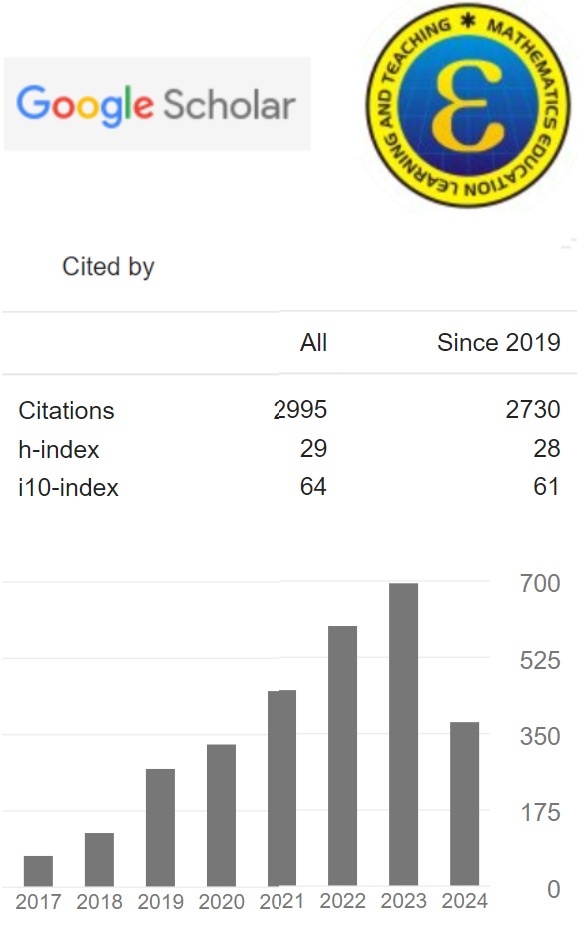Effect of The Application of The Problem Based Learning Model to The Mathematical Problem Solving Ability
(1) Program Studi Pendidikan Matematika STKIP PGRI Sumatera Barat
(2) Program Studi Pendidikan Matematika STKIP PGRI Sumatera Barat
(3) Program Studi Pendidikan Matematika STKIP PGRI Sumatera Barat
(*) Corresponding Author
Abstract
Keywords
Full Text:
PDFReferences
Abdul-Kadir, R., Ibrahim, M., Rahim, Z. H. A., Kamin, S., & Yunus, N. (2003). From traditional teaching to problem-based learning: The Malaysian experience. Abtracts in the programme book of PBL in Dental Education. Victoria Harbour. South Australia. Pg, 42, 317-322.
Arikunto, S. (2010). Research procedure a Practical Approach. Jakarta: Rineka Cipta.
Hendriana, H., Rohaeti, E. E., & Sumarmo, U. (2017). Hard skills dan soft skills matematik siswa. Bandung: Refika Aditama.
Saragih, D., Rajagukguk, W., & Mansyur, A. (2018). The Influence of Problem Based Learning on The Mathematical Problem Solving And Connection Ability of Students In SMP Swasta Assisi Siantar. IOSR Journal of Research & Method in Education, 8(02), 24-30. Retrieved from http://digilib.unimed.ac.id/30392/
Lie, A. (2010). Practicing Cooperative Learning in Classrooms. Jakarta: Grasindo.
Muliyardi. (2002). Strategi Pembelajaran Matematika. Padang: FMIPA UNP.
Nisak, K., & Istiana, A. (2017). Pengaruh Pembelajaran PBL (Problem Based Learning) terhadap Kemampuan Pemecahan Masalah Matematis Siswa. JKPM (Jurnal Kajian Pendidikan Matematika), 3(1), 91-98. Retrieved from https://journal.lppmunindra.ac.id/index.php/jkpm/article/view/2540
Panjaitan, M., & Rajagukguk, S. R. (2017). Upaya Meningkatkan Kemampuan Pemecahan Masalah Matematika Siswa Dengan Menggunakan Model Pembelajaran Problem Based Learning Di Kelas X SMA. INSPIRATIF: Jurnal Pendidikan Matematika, 3(2).1-17. Retrieved from https://jurnal.unimed.ac.id/2012/index.php/jpmi/article/view/8880
Polya, G. (1973). How to solve it 2nd. New Jersey: Princeton University.
Rusman. (2010). Model Pembelajaran. Jakarta: Raja Grafindo persada.
Sudjana. (2005). Metode Statistik. Bandung: Tarsito.
Sugiyono (2013). Metode Penelitian Gabungan. Bandung: Alfabeta.
Sugiyono, D. R. (2001). Statistik Non Parametris untuk Penelitian. Bandung: Alfabeta.
Sumarmo, U. (2013). Berpikir dan Disposisi Matematik serta Pembelajarannya. Bandung: UPI.
Suprihatiningrum, J. (2013). Strategi Pembelajaran Teori dan Aplikasi. Jogjakarta: Ar-Ruzz Media.
Walpole, R. E. (1992). Pengantar statistik, edisi ke-3.[Terjemahan dari Introduction to statistic 3 rd edition]. Sumantri B (penerjemah). PT Gramedia Pustaka Utama. Jakarta.
DOI: 10.24235/eduma.v9i1.5660
Article Metrics
Abstract view : 99 timesPDF - 39 times
Refbacks
- There are currently no refbacks.
Copyright (c) 2020


.png)










